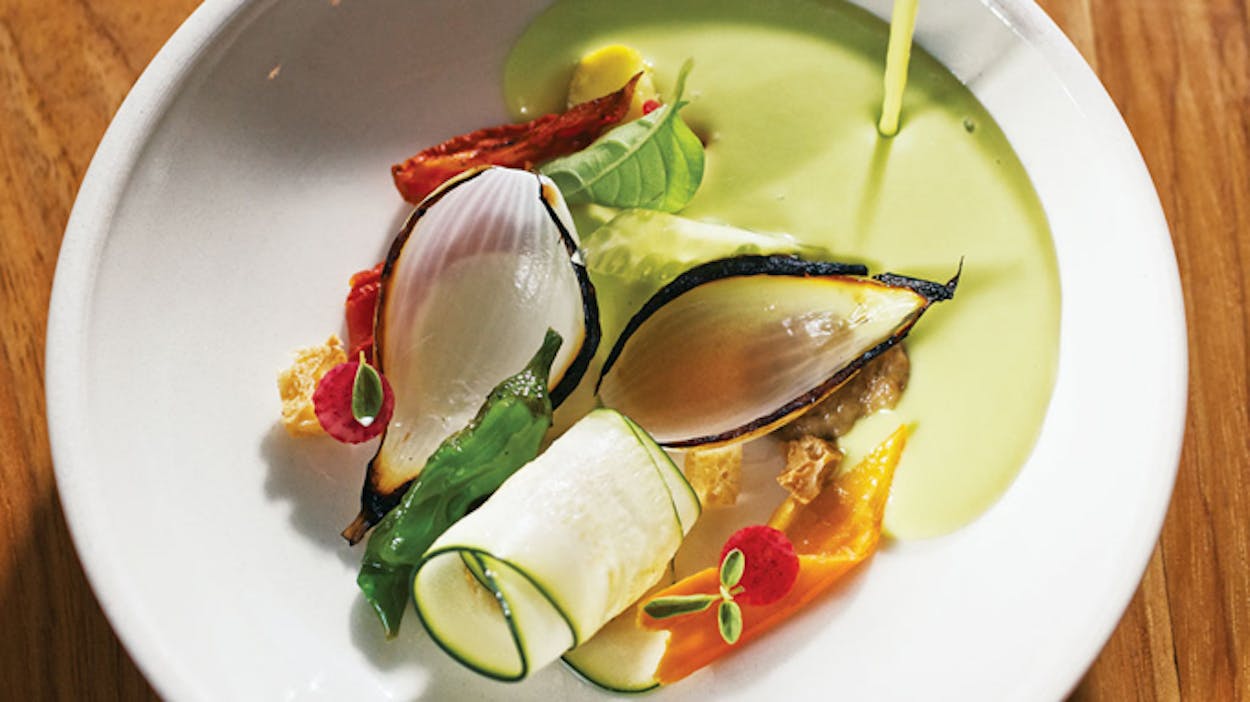When I think about my visit to Paul Qui’s place, three random scenes pop into my head. Scene 1 happened when I spotted two friends laughing like hyenas because they had just grabbed the whimsical ink stamps the restaurant leaves lying around and decorated each other’s arms with images of the restaurant’s crazy little fish-man logo. Scene 2 happened about thirty minutes later, when I was in the tasting room looking at a wooden rack (a.k.a. idea board) festooned with different-sized parcel tags, each labeled with ingredients (combine catfish, sweet potato leaves, and tonka beans—why the hell not?). Scene 3 is from a video on the restaurant’s website, where musician and painter Peelander-Yellow recalls meeting Qui: “He’s a normal guy, but he has a . . . ,” and here the artist makes a loud ffftttsssstttt! noise, like sparks flying from a live electrical wire. What connects the three? Just this: the two-month-old Austin restaurant is not quite like any place I’ve ever been, and if its owner ever has his own TV show, it should be named Paul Qui’s Playhouse.
One would think—after he won Top Chef’s season nine and the James Beard Foundation’s 2012 award for Best Chef: Southwest—that Qui might be getting all serious. I mean, the 33-year-old has investors and a staff, he’s already opened four locations of another restaurant (well, three are food trucks), and he has amassed a rabid fan base. (Happily, his fiancée and manager, Deana Saukam, has a natural talent for social media.) But in spite of the fame, Qui is the same friendly, self-effacing guy he was during the eight years he ascended the ladder at modern Japanese restaurants Uchi and Uchiko. He may be on the cusp of a national career, but he’s not ready to put the toy box away yet.
Sitting at the casual counter that surrounds the open kitchen, observing the cacophonous fifty-seat restaurant, I found that the surroundings’ quirky vibe is even more evident in the food. The first thing that landed in front of my colleague Courtney Bond and me was the evening’s tasty little amuse-bouche, a crackly nori cracker that our server proceeded to squirt, Easy Cheese–style, with homemade cheese mousse made from cloth-aged Cabot Creamery cheddar.
Given that most of the plates are small, we ordered three starters, and in no time, we were gazing at the Ode to Michel Bras (pictured), a two-part play on the array of pristine vegetables popularized by the famous French chef. The first part is a bowl containing gossamer slices of what’s most beautiful and fresh from local farmers. The second part is a pitcher of delicate, pale-green garlic dashi, which is poured into the bowl. The combination of crisp vegetables and silky chilled broth is, in a word, enchanting.
Our second small plate—Salmon Butter—had already become a legend in the five days that Qui had been open. It’s a gorgeous small hunk of olive oil–poached Ora king salmon that you spread on wheat crackers, then sprinkle with chopped cooked egg, a sprig of mint marigold, orange salmon roe, crème fraîche, and pickled red onion. Oh, and flaky pink Murray River salt from New South Wales, rich with minerals and ever so slightly sweet.
Our third plate was the traditional steamed egg custard that is served all over Asia but known as chawanmushi in Japan. Lightly tinged orange, it came in a tall cup with a secret trove of nicely cooked prawns tucked inside, but for some reason, the whole combination fell a little flat. Even the topping, crisp corn and herbed onion-and-tomato sofrito, didn’t give it quite enough oomph. Secretly, I wished I’d kept some of the pickled onion and Murray River salt.
Which brings me to our main course, Rabbit 7 Ways. Looking back, I think we should have indulged in fewer starters before tackling this tour de force (it costs $46 but is easily shared, thank goodness). To me, the two best elements were the delicate, beautifully clear rabbit consommé—served in an adorable white mug with a bunny tail—and the very smooth, very liverish pâté, which comes dusted with freshly ground Indian coriander and sided by a heap of punchy pickled and smoked mustard seeds. While skillfully prepared and eminently flavorful, the five other nibbles, like the rabbit-and-pork ballotine in a lardo wrapper, ended up being, to quote the Dormouse in Alice in Wonderland, much of a muchness.
Since we didn’t ingest nearly enough Cabot cheddar at the beginning of the meal, we were extremely happy to see it reappear in the form of an ice cream sandwich: squares of semisweet cheese ice cream between aerated-waffle-batter cookies covered with drizzles of satiny goat-milk cajeta. Thoroughly sated, we wound our way out amid the small tables in the dining room and courtyard, idly wondering if the following week would be too soon to come back. Some restaurants you get in one visit. But here, the only predictable thing is unpredictability—would the next edition of the menu feature catfish, sweet potato leaves, and tonka beans? I wouldn’t trust just anybody to pull it off. But with Paul Qui, why the hell not?
- More About:
- Paul Qui









